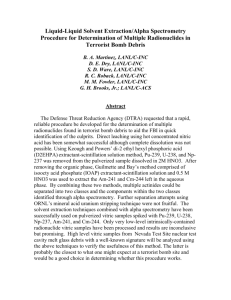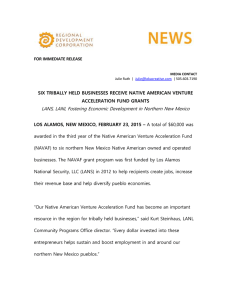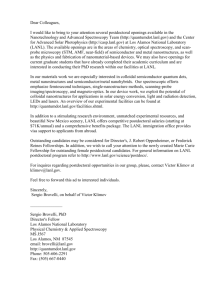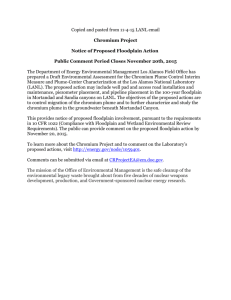Excellence in Science Our Nation Delivering for
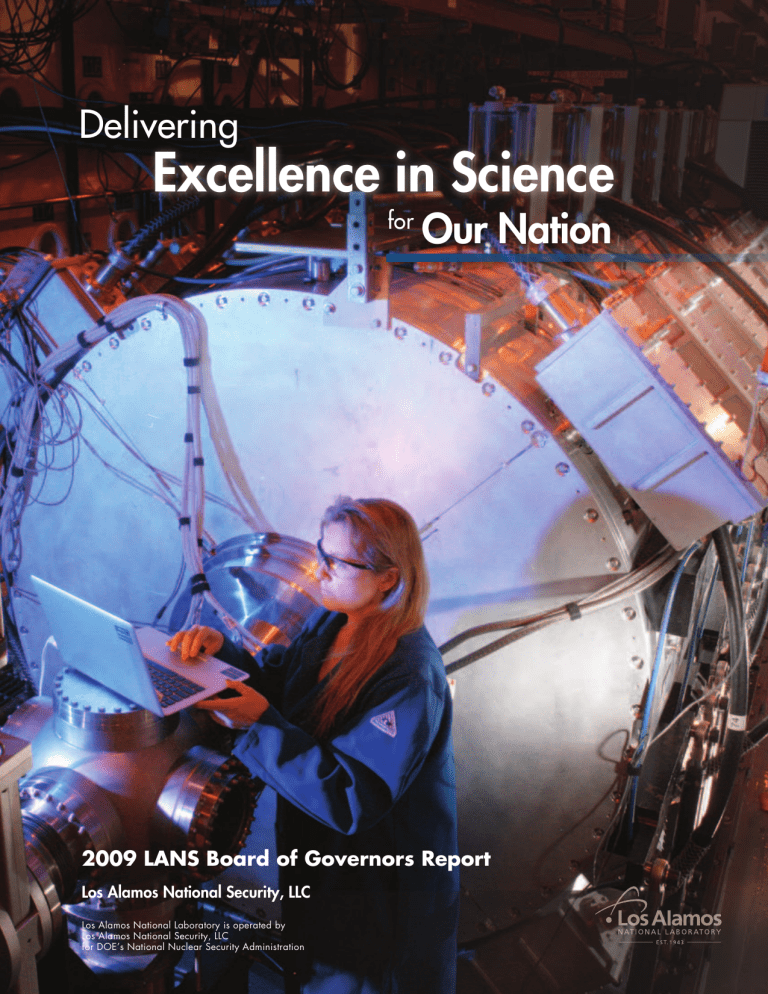
Delivering
Excellence in Science
for
Our Nation
2009 LANS Board of Governors Report
Los Alamos National Security, LLC
Los Alamos National Laboratory is operated by
Los Alamos National Security, LLC for DOE’s National Nuclear Security Administration
“
Los Alamos
National
Security is dedicated to
increasing this
Laboratory’s value as an engine of national security science and technology, one that benefits the nation and the world.
Bearing oversight responsibility for such an institution is sobering, exciting, and gratifying.
This report outlines achievements and challenges, strategies and opportunities associated with national security issues, and the ability of Los Alamos to address them.”
—Norman Pattiz
Chair, LANS, LLC
Board of Governors
Los Alamos National Laboratory geologist Giday WoldeGabriel was part of an international research team responsible for discovering the oldest nearly intact skeleton of Ardipithecus ramidus , who lived 4.4 million years ago.
The discovery of “ARDI” and associated research, which revealed the biology of the first stage of human evolution better than anything seen to date, earned
Science magazine’s Breakthrough of the Year for 2009 and was selected by Time magazine as the No. 1 science story of 2009.
Contents
2
LANS Today
4
Responding to National Needs
6 Strengthening Business and Operations Systems, Tools, and Practices
8
Improving Governance and Sustained Overall Performance
10
Multiyear Strategy for Performance Improvement: FY10–FY14
12
2009 LANS Board of Governors
COVER:
Melissa Reed works on the induction cells of the second axis of the Dual Axis
Radiographic Hydrodynamic Test facility (DARHT) at LANL. This year, DARHT performed the first-ever successful dual axis hydrotest. This double-viewpoint hydrodynamic test will lead to future experiments from LANL and across the nation’s nuclear security enterprise, supporting the stockpile stewardship and weapons assurance mission. (Photo by LeRoy N. Sanchez)
Norman Pattiz
Scott Ogilvie
PROGRESS REPORT
from the Board of Governors
Los Alamos National Security
To: Stakeholders of Los Alamos National Laboratory
Since LANS assumed the contract to manage and operate Los Alamos National Laboratory in 2006, we have been focused on strengthening our stakeholders’ confidence in our ability to deliver excellence in science and outstanding mission performance safely, securely, and in an efficient and effective manner. Through LANS’ governance and oversight and, more important, through the Laboratory’s performance, we believe we are achieving this goal.
Now in our fourth full year managing LANL, we continue to deliver innovative solutions to the nation’s most pressing problems, working as a team with Laboratory employees and subcontractors, in partnership with NNSA. In so doing, we remain committed to leveraging the partners’ cumulative experience to the benefit of the Laboratory.
In this manner, we are building on the Laboratory’s outstanding science, technology, and engineering, which enable our vital stockpile stewardship mission. Our achievements and our response to challenges of the past year reflect our uncompromising commitment to the Laboratory and its vision to be a premier national security science laboratory serving the national interest.
Our governance model relies on strong committees that oversee key LANL functional areas and focus on delivering value to the Laboratory and NNSA. Board members and prominent national leaders serve on and lead these committees, and their work supports the Board’s continuing review and analysis of the functional areas. In addition, the committees routinely contribute sound and valuable counsel to the Laboratory’s management team, working with the managers as they develop business strategies and opportunities and resolve complex management and operational issues. Subsequently, we have developed a five-year strategy for performance improvement at LANL, which is included in this report.
This report showcases outstanding accomplishments of the LANS team in three crucial areas: responding to national needs; strengthening business and operations systems, tools, and practices; and improving governance and sustained overall performance. Though
LANL demonstrated a 42% reduction in recordable accidents since June 2006, the rate of improvement recently reached a plateau. Our challenge is to do better, and we’re intent on making that happen.
We remain fully committed to improving the Laboratory’s work and providing our employees the opportunities and environment to succeed in delivering our mission safely and securely. While we continue to balance challenges with opportunity, we are confident that we will lead LANL toward its full potential as a reliable and responsive laboratory that anticipates, innovates, and delivers to the nation science that matters.
Sincerely,
Norman Pattiz
Chairman, LANS, LLC
Board of Governors
Scott Ogilvie
Vice Chairman, LANS, LLC
Board of Governors
2
LANS Today
The Los Alamos National Security, LLC Board of Governors has provided governance and oversight of LANL management and operations for three and a half years. This report highlights the 2009 accomplishments.
LANS comprises four top U.S. organizations that have extensive experience in nuclear defense programs, large-scale facilities management, and the application of science and technology to national security challenges and safety. The four organizations are Bechtel National, Inc., the University of California, The Babcock & Wilcox Company, and URS
Corporation. Our combined record of accomplishments and awards is unmatched in both science and industry.
LANS initially created a Board of Governors as part of its commitment to support LANL’s leadership team and its management of the Laboratory. The Board operates with discipline and autonomy from the four parent organizations.
The Board of Governors is the conduit through which the
LANS parent organizations provide needed resources and oversight of LANL and promote consolidation, cooperation, and communication across the national laboratory system.
The Board made three fundamental commitments to NNSA.
These commitments and the relevant accomplishments are highlighted in this report:
Responding to national science needs
Strengthening business and operations systems, tools, and practices
Improving governance and sustained overall performance
2009 Highlights
LANL has made steady and significant progress in overall mission and operational performance in the three and a half years LANS has managed and operated the Laboratory. Momentum is building as LANL further applies its outstanding science and engineering to the nation’s emerging challenges.
This year’s report highlights our contribution to the Laboratory’s FY09 accomplishments, our dedication to meeting crucial objectives, and our continuing commitment to enhancing the Labortory’s capabilities, which characterize a premier national security science laboratory in the 21st century.
Responding to National Needs
This year, the Laboratory continued to demonstrate the quality and flexibility of its science, technology, and engineering capabilities in response to changing national needs.
We completed 95% or more of our mission milestones for the third consecutive year while sustaining our leadership in scientific publications among national laboratories. The Laboratory maintained
Roadrunner as one of the world’s fastest supercomputers (applying Roadrunner’s petascale power to open-science applications), decreased the plutonium pit cycle time from an average of 335 days to 114 days, fired the first-ever doubleviewpoint hydrodynamic experiment of a nuclear weapon component mockup, and chartered the development of an institutional plutonium science strategy.
Despina Milathianaki, a Ph.D. student, installs a cover plate on the main experimental chamber of LANL’s
Trident Laser Facility. Through the Trident User
Program, Milathianaki is studying the dynamic response of materials to laser-induced shock loading.
The ability of LANL to respond to new national security science challenges is demonstrated by the 46% growth since
FY06 of our science and energy programs to an FY09 budget level of $267 million. By establishing a new principal associate director-level position to lead a newly elevated global security organization, we have strengthened our response to the Laboratory missions in national and international security.
Improved waste management and pollution prevention practices have to date saved $35 million and increased off-site shipment of transuranic waste sixfold, with a record 131 shipments of transuranic waste sent to WIPP.
Strengthening Business and Operations
Systems, Tools, and Practices
We have accelerated our pace in reducing risk and improving management systems and processes. This year, we took aggressive action to reduce the number and severity of accounting corrections.
The Laboratory defined more than 80 improvement actions, completing 94% of them by following its issues and corrective action management process.
In safety and security, we continue to aggressively pursue improvements. To advance safety performance that had improved but then reached a plateau, we designed a set of actions to accelerate or reinforce efforts that will raise the Laboratory to the next level.
The Laboratory is continuing to build robust and sustainable programs in cyber and physical security, integrating the two more effectively.
To reduce costs, LANL shrunk its footprint by 1 million square feet toward a goal of 2 million.
Improving Governance and Sustained
Overall Performance
We devoted time, energy, and resources toward improving operational performance and reducing risk. We completed all 27 Level 1 milestones to implement Formality of Operations. The in-sourcing of site service support work is saving some $15 million per year.
LANS parent organizations provided project management expertise and oversight to substantially complete construction of the Radiological
Laboratory Utility Office Building
(RLUOB) facility, part of the Laboratory’s Chemistry and Metallurgy
Research Replacement project.
LANL’s contractor assurance system
(CAS) continued to mature enabling the Laboratory to improve performance, anticipate and avoid issues, and mitigate risk.
Distinguished Postdoctoral Research
Fellow Alfred Wooten focuses on the synthesis and characterization of semiconductor, quantum-confined nanostructured materials, specifically nanocrystal quantum dots, rods, and wires, at LANL’s
Center for Integrated Nanotechnologies.
The properties of quantum dots have significant implications for the fields of computing, biology, and energy. By controlling composition and shape, these structures exhibit unique, size-tunable optical and electronic properties for biological, sensor, and photovoltaic applications.
3
4
Responding
to National
Needs
Meeting Our Commitment
This year, we created the new position of principal associate director for Global
Security. This senior management position elevates the importance of the Laboratory’s work in key program areas, including nonproliferation, intelligence support, defense, nuclear counterterrorism, and homeland security.
With LANS support, the Laboratory continued to demonstrate the quality and flexibility of its science, technology, and engineering capabilities. The Laboratory has seen a 46% growth since FY06 in its science and energy programs to
$ 267 million. These capabilities are being leveraged to meet evolving national security challenges while sustaining the scientific basis for a nuclear weapons stockpile that is safe, secure, and reliable.
In environmental stewardship, the Laboratory completed a record year of legacy waste cleanup while sustaining high levels of performance in environmental compliance and pollution prevention.
Bette Korber and Will Fischer, both of Los Alamos National Laboratory’s
Theoretical Biology And Biophysics Group, describe their research entitled
“Fighting HIV/AIDS with Computers” to Department of Energy Secretary
Steven Chu last spring during a visit to the Laboratory.
NATIONAL SECURITY
■
The Board Committee on Nuclear Complex Integration influenced LANL’s work with LLNL to speak with one voice, where possible, on major weapons issues and to lead reform of governance and directives.
■
Members of the Board’s Mission Committee are leaders in shaping nuclear weapons policy at the national level
(e.g., the Congressional Commission on the Strategic
Posture of the United States, Nuclear Posture Review).
■
The Mission Committee interacted with federal decisionmakers at the cabinet level, in particular with DoD about
SCIENCE, TECHNOLOGY,
AND
ENGINEERING
■
LANS, through its Science and Technology Committee, continues to support development of LANL’s concept for a signature science center (MaRIE) that will provide the first comprehensive set of colocated tools to realize transformational advances in materials performance in extreme environments.
■
LANL is developing an institutional plutonium science strategy as a first step toward a Plutonium Center of
Excellence for the DOE Complex .
■
The Science and Technology Committee helped shape Roadrunner open science applications as the initial use of the world’s first petaflop computer, demon-
ENVIRONMENTAL
STEWARDSHIP
■
Key managers from LANS parent companies helped complete a record 131 transuranic waste shipments offsite, including all 16 of LANL’s remote-handled canisters.
■
LANL implemented new operations, recommended by a LANS parent company assessment, which tripled transuranic repackaging operations and completed stockpile life extension approaches and with DOE regarding the need for a nuclear weapons budget uplift for stockpile, science, technology, engineering, and infrastructure.
■
The new Global Security directorate is focused on achieving
LANL’s non-nuclear weapons national security goals.
■
The combined strengths of LANS and LANL are fostering an en- ergy security focus on energy demand growth impacts, sustainable nuclear energy, and clean energy concepts and materials.
■
Capabilities such as high performance computing are being applied to modeling the global impacts caused by increased energy demands.
strating LANL’s role in broad national security issues and as a leader in high performance computing through heterogeneous processors as a path to exascale computing.
■
The Board’s Mission and Science and Technology committees provided input and advice to help define capability delivery for LANL’s mission and program strategy.
■
The Laboratory secured $40 million in science and technology
American Recovery and Reinvestment Act funding for projects focused on alternative and renewable energy research.
■
Staff from prestigious academic institutions peer review the
Laboratory’s science and engineering, thereby providing valuable feedback on performance in these two areas.
■
Compared with 2008, U.S. patent applications in 2009 increased 9%, and total licensing income rose 11%.
MagViz, a device developed by LANL for airport security use, scans a bottle for dangerous carry-on liquids. LANL won one of its six R&D 100 awards in 2009 for this revolutionary technology.
design, installation, and training for a new transuranic drum processing line.
■
The laboratory secured $212 million in American Recovery and
Reinvestment Act funding for environmental cleanup and monitoring, which is expected to create or save up to 350 jobs.
■
LANS resources were assigned to Recovery Act work, including large-scale demolition of 20 unused, Cold War-era Laboratory structures.
Greg Goddard works on a technique to extract algae’s energy-rich lipids and refine them into biofuel, using a new ultrasonic field technology adapted from LANL’s award-winning Acoustic Flow Cytometer.
The Laboratory exceeded its programmatic commitment for repackaging waste drums by 21%.
2,400
2,000
Actual
1,500
Revised Plan
500
FY09 Plan
0
Oct Nov Dec Jan Feb Mar Apr May Jun Jul Aug Sep
5
6
Strengthening
Business and
Operations Systems,
Tools, and Practices
Meeting Our Commitment
LANS oversight has helped the Laboratory realize significant savings and risk reductions in safety, security, and business operations.
In the areas of safety and security, LANL successfully addressed longstanding shortfalls in programs, technical support, management controls, facilities, equipment, and infrastructure—from fire protection and emergency management to material control and accountability (MC&A).
LANL also continued to build robust and sustainable programs in cyber and physical security. LANL improved its cyber incident response capabilities by having cyber security integrate more effectively with physical security.
Leveraging LANS leadership and resources, the Laboratory’s improved business practices and more effective resources management have saved more than $200 million to date in direct costs, pension and benefits costs, state tax liabilities, and travel and procurement costs. Overall, LANL financial management performance continues at a high level.
LANL provides specialized training to Los Alamos firefighters. As a result, these firefighters are better prepared to handle firefighting hazards unique to the Laboratory.
SAFETY
■
While more progress is needed, LANL’s total recordable days away and restricted rates have been reduced since the beginning of the LANS contract in 2006 by
42% and 35%, respectively.
■
With ongoing support from LANS, the Laboratory submitted a VPP application to NNSA.
■
Parent organization experience and support helped validate elements of management actions that were implemented to focus on safety improvements, including establishing Safety Improvement Plans in each director-
SECURITY
■
With guidance from the Board’s Safeguards and
Security Committee, parent companies helped plan a replacement for the archaic and marginally effective
Material Accountability and Safeguards System. The new robust Los Alamos Material Control and Accountability System provides collection, storage, retrieval, and reporting of basic or core information required for all nuclear material accounting and material control program elements.
BUSINESS PROCESSES
AND
SYSTEMS
■
LANL leveraged parent organization resources to build a strong Lean Six Sigma infrastructure, realizing
$45 million in efficiencies in FY09 using Lean Six
Sigma process improvement projects.
■
With support from the Board’s Business and Operations
Committee, parent company IT systems and technical expertise were used to continue the implementation of a Laboratory-wide electronic document management system, which will meet Laboratory needs and allow for the systematic decommissioning of antiquated legacy systems.
ate; expanding behavior-based safety observation programs at select locations; strengthening the injury and illness case management process to focus on prevention; and more active
Worker Safety and Security teams, and expanded employee involvement.
■
Parent corporation reachback has been used for functional management assessments (e.g., waste management) and continues to be critical in developing improved safety basis documents for LANL’s nuclear sites.
Worker Safety and Security Teams are key elements in motivating LANL employees to work safely and achieve Voluntary Protection Program recognition.
■
The Laboratory achieved an overall satisfactory rating for unclassified and classified IT networks as well as a satisfactory rating by NNSA. We created a sustainable path forward to maintain and build upon achievements under the
2008 Security Compliance Order.
■
With strong endorsement from the Safeguards and Security
Committee, the Laboratory established a permanent
Emergency Operations Center, staffed 24/7, to provide a central point of contact for all internal and external communications.
90,000
LANL Accountable Classified Removable
Electronic Media Reduction
87,000
70,000
50,000
30,000
10,000
0
2,524
11/03 5/04 11/04 11/05 3/06 6/06 5/07 CY07 CY08 CY09
■
A team of experts from the parent companies was deployed to assess procurement programmatic training, systems, and tools. The assessment, which engaged NNSA, resulted in recommendations toward establishing a career management program designed to increase the proficiency and productivity of the acquisition workforce through competency-based training.
■
Financial managers provided by LANS in 2006 (chief financial officer, controller, and compliance manager) have led the Laboratory’s 24% performance improvement on financial management measures.
LANL reduced labor cost corrections from FY07 to FY09. In FY07, the percentage of total labor cost corrected totaled 8.2%, with a reduction to 4.0% in FY08 and a further reduction to 2.3% in FY09.
5
3
9
7
1
Reducing Accounting Corrections
2007 2008 2009
7
8
Improving
Governance and
Sustained Overall
Performance
Meeting Our Commitment
This year, to improve our governance role, we instituted joint efforts with Lawrence
Livermore National Security, realizing both performance efficiencies and significant savings. The Board of Governors executive committee also completed a formal in-depth assessment of parent oversight activities, with the goal of taking action in the coming year to reduce costs and improve our governance and oversight model.
In operations, we took advantage of parent companies’ broader skills in facility management—integrating facility and project life cycle management and establishing necessary discipline and rigor in cost estimating—resulting in optimized facility investments and high quality project estimates.
In regional community involvement, independent survey organizations and feedback from regional business leaders, educators, elected officials, and citizens all indicate that LANS’ $3 million annual investment in community programs continues to make a positive difference in people’s lives.
The Lab’s substantially completed Radiological Laboratory Utility Office
Building (RLUOB), part of the first phase of the multiyear Chemistry and
Metallurgy Research Replacement (CMRR) project, will house several mission-critical projects.
Chuck Mielke, standing atop the single-turn coil cage, is the head of the user program at the National High Magnetic Field Laboratory Pulsed
Field Facility. LANL not only supplies the infrastructure to support the operation of the Pulsed Field Facility, but also provides scientific resources such as theorists, complementary scientists, and technicians.
GOVERNANCE
AND
OVERSIGHT
■
Initiated a joint LANS-LLNS self-assessment that will result in adjustments to the governance model, improve efficiencies, and add more value to oversight activities.
■
Combined LANS and LLNS Business and Operations
Committees reducing NNSA costs by at least
$250,000 per year.
■
The Board’s committees provided oversight of LANL functional areas by engaging with management on functional scope and strategy; held them accountable
OPERATIONS
■
In-sourced site support services contractor, saving
$15 million annually.
■
Risks in nuclear and high hazard operations were reduced through declaration of implementation of all planned Level 1 milestones for Formality of Operations, significant progress toward a qualified workforce, and completion of vital safety system assessments for all credited safety-class and safety-significant systems.
■
Highlights of facility construction projects:
Completed the Waste Management Risk Mitigation
Facility, a significant accomplishment in the Lab’s long-term radioactive liquid waste management infrastructure.
COMMUNITY INVOLVEMENT
AND
OUTREACH
■
To date, LANS has invested $2.5 million in regional companies through the Northern New Mexico
Connect program. A survey indicated that the program has yielded 30 new jobs with an average salary of $78,520.
■
As part of its Community Commitment Plan, LANS made available $265,000 in special one-time grants for improved performance; and created opportunities for management to engage at customers’ senior management levels to assure cognizance of challenges and opportunities.
■
Initiated a project to gather information from past three years on parent company functional management reviews in the LANL’s
Issues and Corrective Action Management system. Data will be shared for more effective oversight activity tracking.
■
Obtained assistance from more than 80 parent experts to improve LANL processes and procedures related to nuclear op- erations, physical and cyber security, project management, and business operations, resulting in substantial savings to NNSA.
Substantially completed the CMRR RLUOB in September on schedule and under budget.
Achieved nuclear facility certification from the NNSA and
DNFSB for the nuclear phase of CMRR.
Completed critical project review gates and received authorization to proceed on the LANSCE-R Project, RLUOB equipment installation, Nuclear Materials Safeguards and
Security Project, and the Sanitary Effluent Reclamation Facility.
Completed detonator storage project on time to support a major security commitment made to Congress, resulting in reduced M&O costs.
■
Received DOE certification of the Laboratory’s Earned Value
Management System.
■
Removed 1 million square feet of excess facility space to date.
Ken Rehfeldt, left, discusses with LANL Director Michael Anastasio and
Sen. Jeff Bingaman an initiative to assist the Pueblo of Jemez in harnessing geothermal energy.
to further support area nonprofits already benefitting from the work of LANL employee volunteers.
■
LANS exceeded its promise to match employee contributions up to $1 million in the Laboratory’s annual giving campaign, bringing the total donation to $2.3 million for the United Way.
■
Every year, LANL employees, retirees, and contractors contribute to the Los Alamos Employees’ Scholarship Fund, providing scholarships for students attending U.S. colleges and universities. This year LANS matched employee contributions toward an annual goal of $250,000, thus doubling the scholarships’ impact.
Control room personnel of the Dual Axis Radiographic Hydrodynamic
Test facility oversaw the facility’s first-ever double-viewpoint hydrodynamic test. The first to be tested was a mockup of a W78 warhead.
LANL Employee Giving Campaign Contributions
1,200,000
1,000,000
800,000
600,000
400,000
200,000
0
2006 2007 2008 2009
9
10
Multiyear Strategy for
LANS is committed to managing and operating Los Alamos National Laboratory and improving its scientific and technological excellence for years to come.
Our multiyear performance improvement strategy, accomplished through the following goals of Creating our
Future and Strengthening the Core, is defined through fiscal year 2014 so we can continue to deliver strategic science that provides solutions for our nation’s most pressing challenges.
Reliable Nuclear Deterrence
Assess the safety, reliability, and performance of LANL weapons systems.
– Preserve and enhance the science, engineering, and manufacturing base to sustain the stockpile.
– Continue to assess the LANL-designed warheads in the stockpile.
– Develop future stockpile stewards.
Future Weapons Complex
Achieve NNSA’s Complex transformation for the nation’s nuclear weapons stockpile.
– Integrate weapons program activities to address ongoing and future needs of the Complex.
– Implement transformation changes.
Global Threats and Energy Security
Provide efficient, compliant, and secure infrastructure supported by disciplined operations.
– Anticipate, counter, defeat global threats, and develop a secure energy future.
– Strengthen the Laboratory’s ability to quickly apply our science and technology expertise to chemical, biological, radiological, nuclear, and explosive threats.
– Diversify threat reduction programs by expanding engagement with industry.
National Security Science Laboratory
Become a capabilities-based national security science laboratory.
– Strengthen LANL’s capabilities in energy security.
– Deliver capabilities in critical development areas that enable program funding increases.
– Attract, motivate, recruit, and retain best-in-class talent.
– Demonstrate leadership in supercomputing and predictive science.
Laida Valdez attaches a shield to a target at LANL’s Los Alamos Neutron
Science Center (LANSCE). Using a cat whisker, Valdez applies an ultraviolet curing epoxy to attach the shield.
The completed target will be used in an experiment to determine the effect of an asymmetric drive on the implosion of a fusion capsule.
Performance Improvement: FY10–FY14
Safe, Secure Workplace
Make safety and security integral to every activity we do.
– Ensure a sustainable safety and security infrastructure by mitigating initial risks.
– Continue to strengthen management involvement and employee participation in safety and security.
Exemplary Information Security
Reduce risks while providing seamless information services.
– Become recognized as a model for superior information security practices.
– Develop infrastructure that supports mission needs.
Environmental Stewardship
Establish excellence in environmental stewardship.
– Demonstrate full compliance with environmental regulations and requirements.
– Deploy effective and efficient solutions to improve environmental performance.
Responsive Infrastructure
Provide efficient, compliant, and secure infrastructure supported by disciplined operations.
– Modernize facilities to align with mission needs while balancing available investment funding and optimal space utilization.
– Operate LANL facilities to be consistently safe, secure, and environmentally compliant.
– Ensure infrastructure is managed effectively to accomplish DOE missions.
Performance-Based Management
Enable mission and operational excellence.
– Reduce cost and improve quality.
– Identify and fix performance deficiencies and deliver on customer commitments in mission and operations.
Business Excellence
Deliver cost-effective business systems that meet LANL’s business needs.
– Deliver modern and integrated business systems/processes/tools as a competitive advantage to mission accomplishment.
Effective Communications and Community Programs
Communicate our value as a national laboratory, as an employer, and as a good corporate citizen.
– Strengthen communication and engagement with employees, customers, community, and stakeholders.
– Enhance LANL’s reputation as a good corporate citizen.
Successful Workforce
Cultivate a work environment where employees are empowered to achieve success.
– Deliver human capital systems that support and sustain recruiting, hiring, training, and retaining the best workforce in the NNSA Complex.
11
12
2009 LANS
Board of Governors
ExECutivE COmmittEE
Norman Pattiz
Scott Ogilvie
Chairman; Regent, University of California; Founder and Chairman, Westwood One, Inc.
Vice Chairman; President, Bechtel Systems and Infrastructure, Inc.
S. Robert Cochran President, Babcock & Wilcox Technical Services Group; Co-chair of the Safeguards and Security Committee
Bruce Darling Executive Vice President, University of California; Chair of the Nominations and Compensation Committee
William Frazer
Craig Weaver
Senior Vice President Emeritus, University of California; Chair of the Science and Technology Committee
Executive Vice President, Bechtel Systems and Infrastructure, Inc.; Chair of the Business and Operations Committee
iNDEPENDENt GOvERNORS
Sidney Drell Senior Fellow, Hoover Institution, Stanford University; Vice Chair of the Mission Committee
Richard mies Admiral (Retired), U.S. Navy; Former Commander, U.S. Strategic Command; Chair of the Nuclear Weapons
Complex Integration Committee
Nicholas moore Global Chair (Retired), PricewaterhouseCoopers; Chair of the Ethics and Audit Committee
William Perry Senior Fellow, Hoover Institution, Stanford University; Former Secretary of Defense; Chair of the
Mission Committee
Nick Salazar State Representative, New Mexico Legislature
ADviSORy mEmBERS
Steven Beckwith Vice President for Research and Graduate Studies, University of California tom Gioconda Brigadier General (Retired) U.S. Air Force; former Acting Deputy Administrator for Defense Programs (NNSA);
Vice President and Manager of Government Programs, Bechtel National, Inc.; Co-chair of the Safeguards and
Security Committee; Vice Chair of the Nuclear Weapons Complex Integration Committee
Bruce varner
David Walker
Regent, University of California; Partner, Varner & Brandt LLP
President, Bechtel National, Inc.; Vice Chair of the Business and Operations Committee
BOARD OF GOvERNORS COmmittEES
Business and Operations; Ethics and Audit; mission; Nominations and Compensation; Nuclear Weapons Complex integration;
Safeguards and Security; Science and technology
From left to right: State Rep. Jeannette Wallace, Sen. Pete Domenici,
LANL Director Michael Anastasio, and State Rep. and LANS
Independent Governor Nick Salazar gathered this year around the plaque that designates the Laboratory’s National Security Science
Building, the Nicholas Metropolis Center for Modeling and
Simulation, and the Nonproliferation and International Security
Center collectively as the Pete V. Domenici National Security
Science Complex.
LOS ALAMOS
NATIONAL SECURITY, LLC
FY09 LANL COSTS
LEGEND:
NNSA Weapons Programs
NNSA Nonproliferation
NNSA Safeguards and
Security
DOE Environmental
Management
DOE Energy and Other
Programs
DOE Office of Science
Work for Others
Work for Others
(National Security)
NNSA programs represent 70% of the
Laboratory’s operating program portfolio.
LANL also spent $8M in FY09 on one-time stimulus projects.
$87M
$73M
$87M
$228M
$130M
$166M
$175M
$1,218M
$2.2 Billion
NNSA Funding
LANS ORGANIZATION
Board of Governors
President and Laboratory Director
Michael R. Anastasio
Science and
Technology
Missions and Programs
Global
Security
Weapons
Programs
Energy
Security
Environmental
Management
Laboratory and Business
Operations
13
Los Alamos National Security, LLC www.LANL.gov
www.LANSLLC.com
Los Alamos National Laboratory, an affirmative action/ equal opportunity employer, is operated by Los Alamos
National Security, LLC, for the National Nuclear Security
Administration of the U.S. Department of Energy under contract DE-AC52-06NA25396.
Capitalizing on NNSA’s investment, Los Alamos scientists this past year harnessed the blazing speed of the Lab’s
Roadrunner supercomputer, the first to reach a petaflop (a million billion calculations per second).
Prior to Roadrunner’s transition to classified computing to assure safety, security, and reliability of the U.S. nuclear deterrent, LANL used the system for accelerated petascale computer modeling and simulations for 10 fundamental science projects. These leading-edge efforts ranged from single-atom modeling of nanowires to the largest-ever computer model focused on understanding both dark matter and dark energy.
LA-UR-10-00300
Printed on recycled paper
30% post-consumer waste
